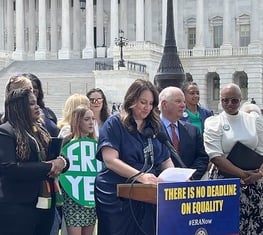Maybe Yes, Maybe No: Our Democracy Hangs in the Balance
On Tuesday morning, the Supreme Court heard what we hope will be the historic case of Gill v. Whitford. Why historic? Because the case represents the last chance, probably for decades, for the Court to rule that excessive partisan gerrymandering violates the Constitution. The League filed an amicus curiae brief in the case and we dearly hope that the Court blocks partisan gerrymandering. It could be a decision as important for democratic government as the “one person – one vote” decision that brought fundamental change to state legislatures and revolutionized American politics.

First, a little background: The last time the Court considered a partisan gerrymandering case was more than a decade ago in the case of Vieth v. Jubelier. The Court divided 4 – 1 – 4, with four Justices willing to overturn a Pennsylvania partisan redistricting plan and four opposed. The deciding vote belonged to Justice Anthony Kennedy, who agreed that excessive partisan redistricting could violate the Constitution but said he couldn’t find a standard by which to judge when a plan was excessively partisan. He also suggested that the First Amendment’s associational and free speech rights might be a better basis for overruling partisan gerrymandering than the Equal Protection argument traditionally used.
Then came the Wisconsin legislature. After taking control of both houses and the Governor’s mansion in 2010, Republicans produced a redistricting plan that is the most partisan observers have ever seen. And they did it on purpose, using computer programs and all the tools of our modern age. Moreover, they repeatedly fine-tuned the plan, not only to ensure a Republican majority in the next election, but to achieve a majority in the legislature for a full decade, no matter how the voters voted.
Gill v. Whitford is the challenge to this partisan redistricting plan. Plaintiffs argue that the plan does violate the First Amendment as well as the Equal Protection clause. And they used a new formulation that could provide a standard for courts to use. This is the “efficiency gap,” which measures the extent of “packing and cracking” -- the practice of concentrating the other party’s voters in just a few districts or distributing them so widely that their votes don’t affect the outcome – as well as partisan symmetry – whether each party would win the same number of seats if each received a certain number of votes.
On Tuesday morning, all eyes were on Justice Kennedy. Everyone knew that he holds the crucial vote. They also knew that he is contemplating retirement, with his life-time replacement expected to join the Court’s conservatives in opposing any ruling against partisan gerrymandering.
First the Court dealt with the technical issue of standing. The entire state-wide plan is being challenged in this case. But in racial gerrymandering cases, only a single district can be challenged, and some suggest this precedent means that the particular plaintiffs can’t come to court to challenge the Wisconsin partisan gerrymander. During oral argument, however, Justice Kagan pointed out that in “one person – one vote” cases, a statewide plan can be challenged, providing a different possible precedent for this case.
Seeking additional ways to dispose of the case without reaching the merits, Chief Justice Roberts worried at length that the Supreme Court would be flooded with cases if the Wisconsin plan were overturned using ambiguous standards and that this would enmesh the Court too much in partisan politics. (As if Bush v. Gore and Citizens United v. FEC hadn’t already done that!) In response, it was pointed out that courts apply standards that aren’t rigid every day.
Then Justice Kennedy asked, "If the state has a law or constitutional amendment that's saying all legitimate factors must be used in a way to favor party X or party Y, is that lawful?" The attorney arguing in favor of the Wisconsin plan was nonplussed, knowing that Justice Kennedy was giving an example that he clearly thought was unconstitutional. And Justice Kennedy continued, asking whether the example would be a violation of the First Amendment.
Several members of the Court then asked about the judicial standards that might be used in the case, with the conservatives arguing that the efficiency gap wouldn’t really work and the liberals suggesting that it is a useful tool along with other criteria, including one-party control of the redistricting process. Justice Kennedy remained silent during this back and forth.
What will be the outcome of Gill v. Whitford? Making predictions after oral argument is a fool’s errand. But we know it could have huge importance. If the Wisconsin plan stands, it will just be a footnote in the decline of American representative government. But if it is overturned, it will be like an earthquake, affecting redistricting at every level of government and once again fundamentally changing American politics. All eyes remain on Justice Kennedy.
Sign Up For Email
Keep up with the League. Receive emails to your inbox!
Donate to support our work
to empower voters and defend democracy.





